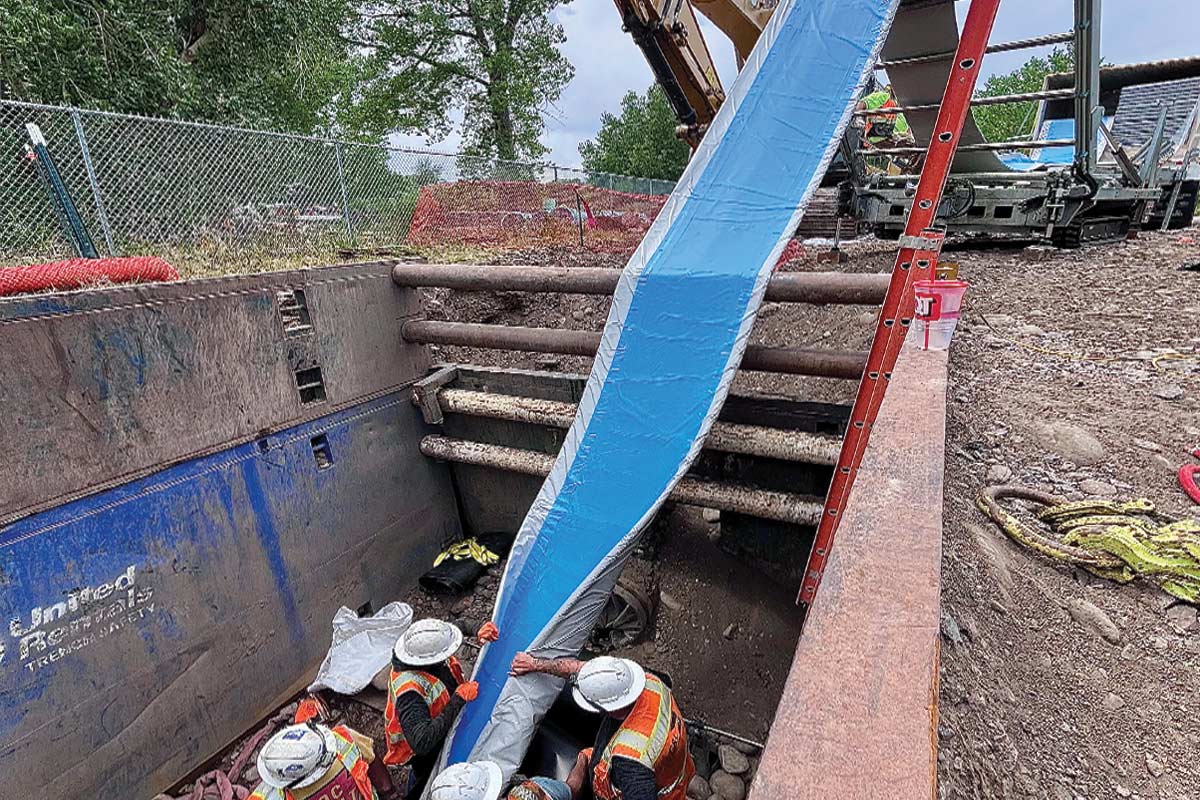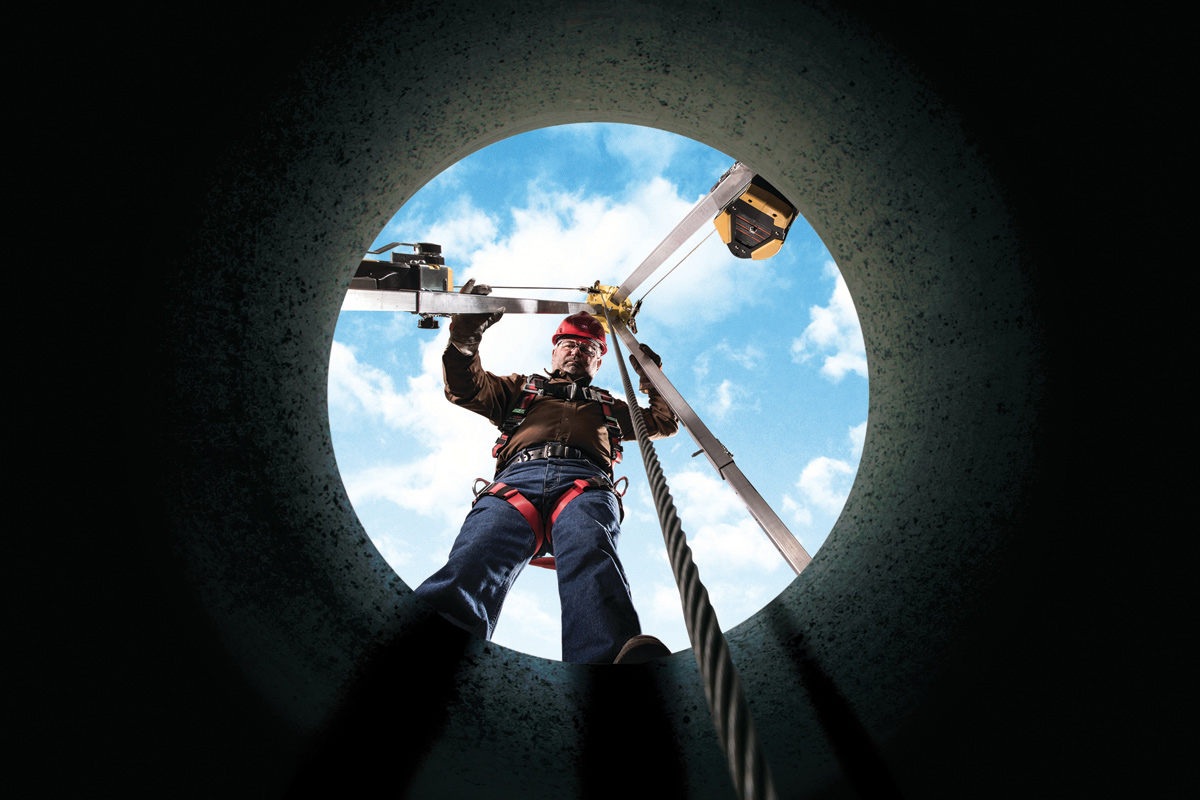
ISS Kanal Services Relines Two DN 1,200-mm Release Lines with 40 Percent Incline in the Campocologno, Switzerland, Hydroelectric Power Station
March 9, 2015
 REPOWER AG operates the Campocologno hydroelectric power station in the Swiss Canton of Graubünden, right on the Italian border. Water for energy generation is taken from Lago di Poschiavo via a tunnel to the Monte Scala water tower from where it is taken through open-trench pressure pipes to the Campocologno power station. Annual electricity production of 183.5 gigawatt hours is achieved by two Francis turbines each with a 25MW capacity.
REPOWER AG operates the Campocologno hydroelectric power station in the Swiss Canton of Graubünden, right on the Italian border. Water for energy generation is taken from Lago di Poschiavo via a tunnel to the Monte Scala water tower from where it is taken through open-trench pressure pipes to the Campocologno power station. Annual electricity production of 183.5 gigawatt hours is achieved by two Francis turbines each with a 25MW capacity.When the power station was built in 1904-1907, it set a new technological record in terms of its drop height of 418 m.
Two release lines, each with a DN 1,200-mm diameter, fulfill an important safety function for the power station. If the Monte Scala water tower were suddenly to close, then these lines would release the pressure. The lines — built in 2002 — have a 40 percent incline and are made of wood. They began to show signs of wear and leakage in places. REPOWER AG contracted Swiss duct renovation firm ISS Kanal Services to carry out rehabilitation. Their remit was to reinstate the static sealing and load-carrying capacity of the pipes (interior and exterior pressure). The Alphaliner process in its special RELINEEUROPE AlphalinerHP version was identified as an appropriate rehabilitation process.
Difficult Construction in Steep Mountainous Areas
The challenge in this rehabilitation process was its situation: at a height of 1,060 m on a steep mountainous site. The upper structure of the water tower is 3 m below road level and rises out of the steep mountainside. This could not be accessed directly by vehicles via the single-track road between Campascio and Monte Scala, requiring that the crates of lining materials, as well as the heavy equipment such as the conveyor belt necessary for installing the liner, had to be put into position by crane. In order to establish a level standing for the truck crane supports, ISS built a structure made of railway sleepers next to the road. Nevertheless, because of the restricted construction site, traffic on the road had to be halted during craning operations. The vehicle carrying the UV-curing unit was positioned in a lay-by on the road.
Safety Measures for 2.6 Tonne Liners
The upper structure on which the crates containing the 2.6 tonne hose liners and the conveyor belt for installing the liners were placed was covered with a grille. The static load-bearing capacity was, therefore, checked beforehand. ISS had erected a structure of wooden beams to distribute the weight of the materials more evenly. In order to attach the cable winch, a 60-cm hole had to first be drilled in the cover of the lower section of the structure. An emergency switch-off at the power station would result in pressures of 20 tonnes per cm2 and so this heavy concrete cover is 85-cm thick.
As soon as the supply lines for power and compressed air had been laid between the supply vehicle and the site, rehabilitation work could begin. Using the conveyor belt and the cable winch, the hose liner was lowered 6 m from the roof of the structure and then moved a further 6 m horizontally. The chamber in front of both pipelines was only1.5 m high, which meant that ISS team members had to carry out all their work either bent over or on their knees. Unusual procedures were also necessary in order to secure the heavy liner. It was important to prevent the liner, in its steep position, from slipping under its own considerable weight. Heads were, therefore, secured at either end. At one end, the cable winch pulled the “end head” in the top section, which was secured with cables to the walls of the structure. The most meticulous bends in the longitudinal direction of the conveyor belt prevented the liner falling in on itself.
Particular skill by the team members was also called for in installing the sealing packager and inserting the light chain. To do this, the upper section of the liner was cut open and lifted up to the concrete cover using deflection rollers. The total weight was borne by the lower section of the liner. To guide the light chain safely over the bend in the liner at the join between the floor of the structure and the steeply sloping pipe, ISS mounted smaller wheelsets than those normally used for DN 1,200 mm. This gave the light source a greater clearance from the liner wall that was compensated by a slightly reduced curing speed.
High Safety Requirements for the Liner Material
If the water tower is closed due to an emergency switch-off at the power station, the release lines must withstand pressure of 2.5 bar. Maximum operational pressure is 1 bar. For this rehabilitation project, ISS Kanal Services used the AlphlinerHP, which has been specially developed by RELINEEUROPE for rehabilitating lines. This high performance liner has a special sandwich construction and an additional outer casing creating a double wall. This provides double security against infiltration and ex-filtration. In this case, this version of the liner was used as a double safeguard for liner tightness even in the event of a possible pressure surge. The static wall thickness required for the installed AlphalinerHP was 10 mm.
Thanks to good planning and a motivated team, ISS Kanal services employees working closely with RELINEEUROPE were able to complete this unusual and challenging rehabilitation task within two working days. The curing time for both Alphaliners also demanded a short time-scale. The powerful RELINEEUROPE 6 x 2,000 Watt light source was used. With a pulling speed of 0.6 m/min., both 40-m long release lines were each completely cured within an hour.
Flexibility of UV light
This rehabilitation technique appears to demonstrate the potential of Alphaliner technology and the speed and flexibility of UV light curing.
Both long and short individual sections (as in this case) can be rehabilitated in the shortest time-scale using this technology. Using high-performance Alphaliner UV technology the DN 1,200 Alphaliners with 10-mm thick walls and a curing speed of 0.6 m/min.; i.e. just on 40 m an hour, could be completely cured Alphaliner UV technology also allows for the application of various performance levels for the UV lamps used, depending on diameter. The light source used with its 2,000W lamps can be ignited at performance levels 1,000 W, 1,200 W, 1,500 W and 2,000 W; 1,000 W are used for DN 600 and 2,00 W for large diameters up to DN 1300 in order to cure each liner wall thickness in a controlled and monitored fashion. The use of the 2,000-W performance option would not be ideal for a nominal width of DN 600 in terms of intensity and resulting temperatures.
This rehabilitation measure in Campocologno could only be implemented using UV light curing. UV hardened hose liners are stable in comparison with heat-hardened systems and can be stored for months before installation, provided they are protected from UV light. The Alphaliner could therefore be transported without any problem into the mountains to the construction site and then by crane to the starting shaft. The ISS Kanal Service AG UV curing unit is equipped with a 300-m long curing cable. This could be rolled out via deflection rollers from the vehicle to the starting shaft so that it was possible to carry out an orderly and controlled curing process on the Alphaliner, even in such difficult terrain.
The AlphalinerHP
Based on a high-quality polyester resin (UP resin compliant with DIN EN 13121 Group 4, in compliant with DIN 16946-2 Type 1140, in compliance with DIN 18820 Group 3), a special version of the AlphalinerUP, the AlphalinerHP was developed for renovating tunnels in sensitive areas with particularly high safety requirements.
With reference to its mechanical properties, two types of liner provide characteristic values for various static loading capacities.
| Material | Alphaliner500 | Alphaliner1500 |
| E-Module Short time value 5% quantile as per DIN EN 1228 | 9,776 MPa | 12,752 MPa |
| E-Module 5% quantile long time value | 6,110 MPa | 9,588 MPa |
| E-Module 5% quantile short time value as per DIN EN ISO 178 | 8,500 MPa | 12,300 MPa |
| Flexural strength short time value as per DIN EN ISO 178 | 180 MPa | 210 MPa |
| Flexural strength long time value | 110 MPa | 155 MPa |
| Reduction factor 50 years | 1.6 | 1.33 |
| Glass fibre quality | ECR | ECR |
Table 1: Mechanical properties Alphaliner 500 and Alphaliner 1500
Particularly high demands are made of the tunnel rehabilitation systems used in some areas.
- Ground water protection zones II and III
- High-intensity traffic zones
- Development areas/ areas of mining subsidence / marshland
These areas have a higher requirement for water-tightness and longer curing times, as well as for preventing any possible water contamination in the course of the rehabilitation process. The RELINEEUROPE AlphalinerHP represents a hose liner system, which meets these exacting requirements. The AlphalinerHP has a special and unique sandwich construction. The resin-rich inner coating and the static bearing part of the glass fiber reinforcement are complemented by a unique resin-rich rear wall, which creates a water-tight outer casing around the liner as additional protection and is securely attached to the Alphaliner. Whereas conventional hose liners use only foil backings, this special outer casing gives extra security in particularly demanding applications in regard to infiltration and ex-filtration.
The smooth, resin-rich inner surface/wearing course of the Alphaliner exhibits the best hydraulic characteristics because of its particularly resin-rich inner coating. This wearing course is 0.5-mm thick. This gives the Alphaliner the greatest abrasion resistance in terms of mechanical stresses.
Christian Noll is director at RELINEEUROPE AG and Nicolaus Dick is division manager services at RELINEEUROPE AG







